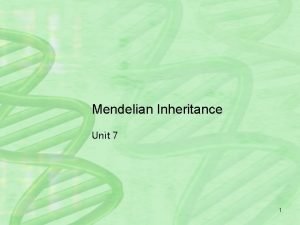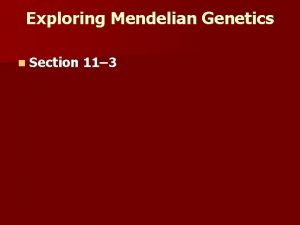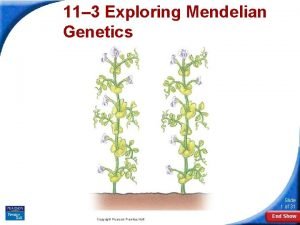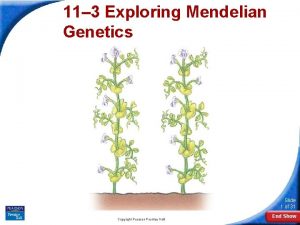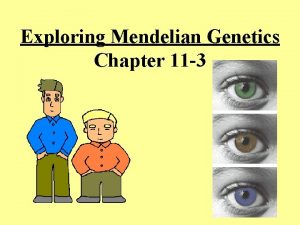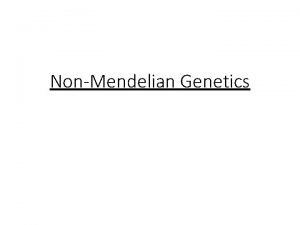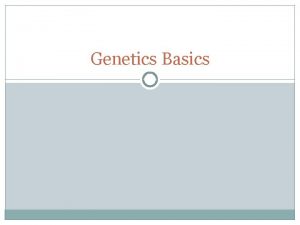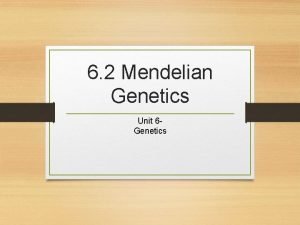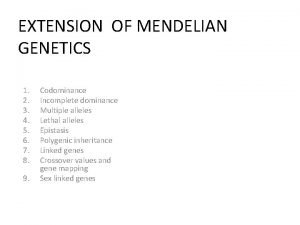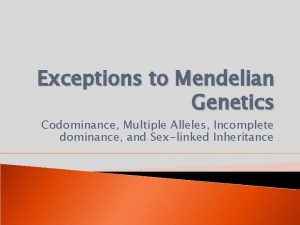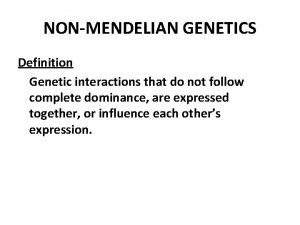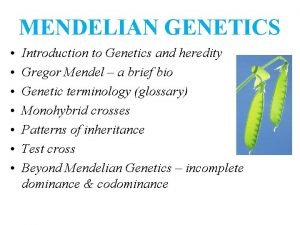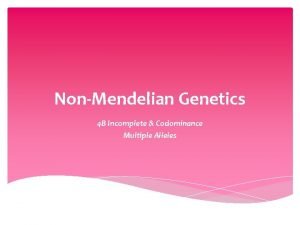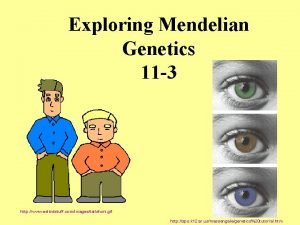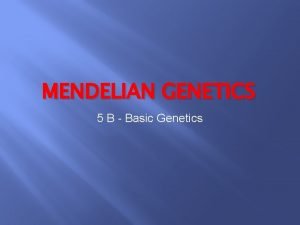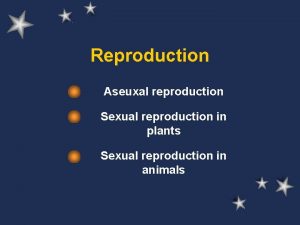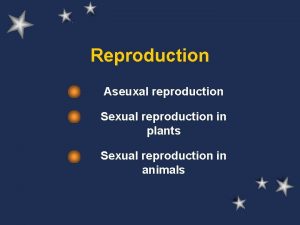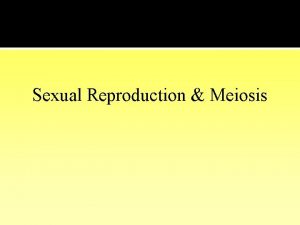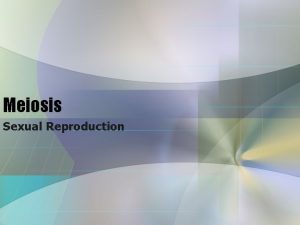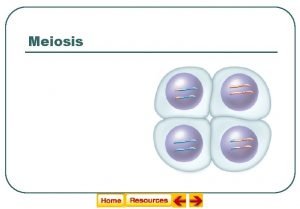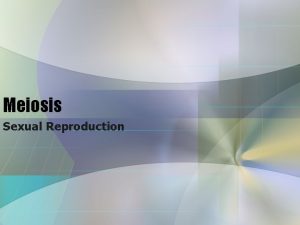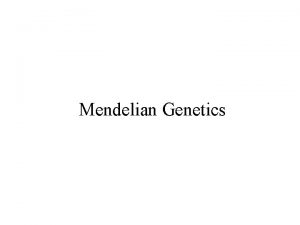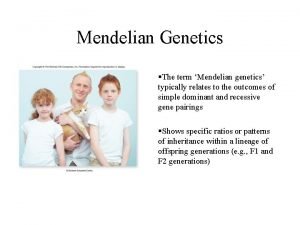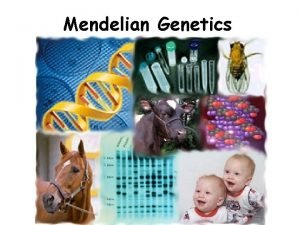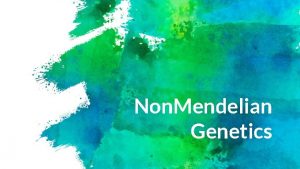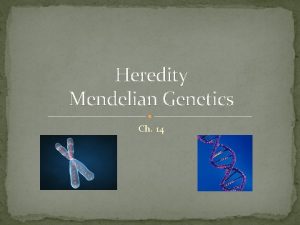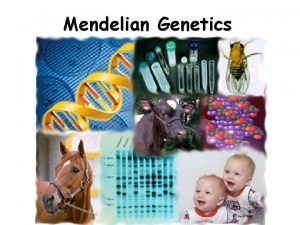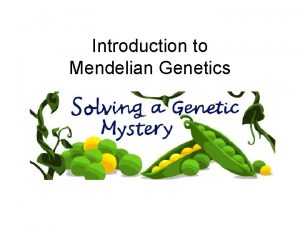Sexual Reproduction and Genetics Section 2 Mendelian Genetics




































- Slides: 36


Sexual Reproduction and Genetics Section 2: Mendelian Genetics Section 3: Gene Linkage and Polyploidy Click on a lesson name to select.

Section 2 Sexual Reproduction and Genetics Mendelian Genetics How Genetics Began § The passing of traits to the next generation is called inheritance, or heredity. § Mendel performed cross-pollination in pea plants. § Mendel followed various traits in the pea plants he bred.

Section 2 Sexual Reproduction and Genetics Mendelian Genetics § The parent generation is also known as the P generation.

Section 2 Sexual Reproduction and Genetics Mendelian Genetics § The offspring of this P cross are called the first filial (F 1) generation. § The second filial (F 2) generation is the offspring from the F 1 cross.

Section 2 Sexual Reproduction and Genetics Mendelian Genetics § Mendel studied seven different traits. § Seed or pea color § Flower color § Seed pod color § Seed shape or texture § Seed pod shape § Stem length § Flower position

Section 2 Sexual Reproduction and Genetics Mendelian Genetics Genes in Pairs § Allele § An alternative form of a single gene passed from generation to generation § Dominant § Recessive

Section 2 Sexual Reproduction and Genetics Mendelian Genetics Dominance § An organism with two of the same alleles for a particular trait is homozygous. § An organism with two different alleles for a particular trait is heterozygous.

Section 2 Sexual Reproduction and Genetics Mendelian Genetics Genotype and Phenotype § An organism’s allele pairs are called its genotype. § The observable characteristic or outward expression of an allele pair is called the phenotype.

Section 2 Sexual Reproduction and Genetics Mendelian Genetics Mendel’s Law of Segregation § Two alleles for each trait separate during meiosis. § During fertilization, two alleles for that trait unite. § Heterozygous organisms are called hybrids.

Section 2 Sexual Reproduction and Genetics Mendelian Genetics Monohybrid Cross § A cross that involves hybrids for a single trait is called a monohybrid cross.

Section 2 Sexual Reproduction and Genetics Mendelian Genetics Dihybrid Cross § The simultaneous inheritance of two or more traits in the same plant is a dihybrid cross. § Dihybrids are heterozygous for both traits.

Section 2 Sexual Reproduction and Genetics Mendelian Genetics Law of Independent Assortment § Random distribution of alleles occurs during gamete formation § Genes on separate chromosomes sort independently during meiosis. § Each allele combination is equally likely to occur.

Section 2 Sexual Reproduction and Genetics Mendelian Genetics Punnett Squares § Predict the possible offspring of a cross between two known genotypes Punnett Squares

Section 2 Sexual Reproduction and Genetics Mendelian Genetics Punnett Square— Dihybrid Cross § Four types of alleles from the male gametes and four types of alleles from the female gametes can be produced. § The resulting phenotypic ratio is 9: 3: 3: 1.

Section 3 Sexual Reproduction and Genetics Gene Linkage and Polyploidy Genetic Recombination § The new combination of genes produced by crossing over and independent assortment § Combinations of genes due to independent assortment can be calculated using the n formula 2 , where n is the number of chromosome pairs.

Section 3 Sexual Reproduction and Genetics Gene Linkage and Polyploidy Gene Linkage § The linkage of genes on a chromosome results in an exception to Mendel’s law of independent assortment because linked genes usually do not segregate independently.

Section 3 Sexual Reproduction and Genetics Gene Linkage and Polyploidy § Polyploidy is the occurrence of one or more extra sets of all chromosomes in an organism. § A triploid organism, for instance, would be designated 3 n, which means that it has three complete sets of chromosomes.

Chapter Sexual Reproduction and Genetics Chapter Diagnostic Questions Which symbol is used to represent the number of chromosomes in a gamete? A. # B. x C. r D. n 1. 2. 3. 4. A B C D

Chapter Sexual Reproduction and Genetics Chapter Diagnostic Questions Name the person known as the father of genetics. A. Felix Mendelssohn B. Gregor Mendel C. Dr. Reginald Punnett D. Albert Einstein 1. 2. 3. 4. A B C D

Chapter Sexual Reproduction and Genetics Chapter Diagnostic Questions Which term refers to the outward expression of an allele pair? A. gamete B. hybrid C. phenotype D. genotype 1. 2. 3. 4. A B C D

Chapter Sexual Reproduction and Genetics Section 2 Formative Questions What is the name for different forms of a single gene that are passed from generation to generation? A. alleles B. genotypes C. phenotypes D. traits 1. 2. 3. 4. A B C D

Chapter Sexual Reproduction and Genetics Section 2 Formative Questions Which pair of alleles is heterozygous? A. RR B. Rr C. rr D. y. R 1. 2. 3. 4. A B C D

Chapter Sexual Reproduction and Genetics Section 2 Formative Questions In rabbits, gray fur (G) is dominant to black fur (g). If a heterozygous male is crossed with a heterozygous female, what is the phenotypic ratio of the possible offspring? A. 1: 1 B. 1: 2: 1 C. 2: 1 D. 3: 1 1. 2. 3. 4. A B C D

Chapter Sexual Reproduction and Genetics Section 3 Formative Questions Two genes on the same chromosome may become separated during meiosis. A. true B. false 1. 2. A B

Chapter Sexual Reproduction and Genetics Section 3 Formative Questions What is the term for an organism that has one or more sets of extra chromosomes in its cells? A. diploid B. gamete C. hybrid D. polyploid 1. 2. 3. 4. A B C D

Chapter Sexual Reproduction and Genetics Chapter Assessment Questions How many chromosomes would a cell have during metaphase I of meiosis if it has 12 chromosomes during interphase? A. 6 B. 12 C. 24 D. 36 1. 2. 3. 4. A B C D

Chapter Sexual Reproduction and Genetics Chapter Assessment Questions Which stage of meiosis is illustrated? A. prophase I B. interphase C. anaphase I D. anaphase II 1. 2. 3. 4. A B C D

Chapter Sexual Reproduction and Genetics Chapter Assessment Questions What is the next step for the chromosomes illustrated? A. Chromosomes replicate. B. Chromosomes move to opposite poles. C. Chromosomes D. Chromosomes 1. uncoil and form two nuclei. 2. 3. line up at the equator. 4. A B C D

Chapter Sexual Reproduction and Genetics Standardized Test Practice What is this process called? A. fertilization B. gamete formation C. inheritance D. reproduction 1. 2. 3. 4. A B C D

Chapter Sexual Reproduction and Genetics Standardized Test Practice Before meiosis I, the sister chromatids of this chromosome were identical. What process caused a change in a section of one chromatid? A. DNA replication B. crossing over C. synapsis D. telophase 1. 2. 3. 4. A B C D

Chapter Sexual Reproduction and Genetics Standardized Test Practice At what stage is the chromosome number reduced from 2 n to n? A. prophase I B. metaphase I C. anaphase I D. meiosis II 1. 2. 3. 4. A B C D

Chapter Sexual Reproduction and Genetics Standardized Test Practice To which step in this process does the law of segregation apply? A. grows into plant B. gamete formation C. fertilization D. seed development 1. 2. 3. 4. A B C D

Chapter Sexual Reproduction and Genetics Standardized Test Practice For human eye color, brown is dominant and blue is recessive. If a husband is heterozygous and his wife has blue eyes, what is the probability that their child will have blue eyes? A. 0 B. 1/4 C. 1/2 D. 1 1. 2. 3. 4. A B C D

Section 2 Sexual Reproduction and Genetics Vocabulary Section 2 genetics phenotype allele dominant recessive homozygous heterozygous genotype law of segregation hybrid law of independent assortment

Section 3 Sexual Reproduction and Genetics Vocabulary Section 3 genetic recombination polyploidy
 Section 1 meiosis
Section 1 meiosis Chapter 10 section 3 gene linkage and polyploidy
Chapter 10 section 3 gene linkage and polyploidy Sexual reproduction and asexual reproduction
Sexual reproduction and asexual reproduction Mendelian genetics
Mendelian genetics Chapter 10 sexual reproduction and genetics
Chapter 10 sexual reproduction and genetics Binary fission in bacteria
Binary fission in bacteria Asexual reproduction vs sexual reproduction venn diagram
Asexual reproduction vs sexual reproduction venn diagram Family resemblance test
Family resemblance test Section 11-3 exploring mendelian genetics answer key
Section 11-3 exploring mendelian genetics answer key Section 11-3 exploring mendelian genetics
Section 11-3 exploring mendelian genetics Chapter 10 section 2: mendelian genetics
Chapter 10 section 2: mendelian genetics 11.3 exploring mendelian genetics
11.3 exploring mendelian genetics Section 11-3 exploring mendelian genetics
Section 11-3 exploring mendelian genetics Section 11-3 exploring mendelian genetics
Section 11-3 exploring mendelian genetics Is baldness a sex linked trait
Is baldness a sex linked trait Mendelian traits
Mendelian traits Extending mendelian genetics chapter 7
Extending mendelian genetics chapter 7 Mendel was a
Mendel was a Extending mendelian genetics answer key
Extending mendelian genetics answer key Extension of mendelian genetics
Extension of mendelian genetics Multiple alleles
Multiple alleles Chapter 7 extending mendelian genetics vocabulary practice
Chapter 7 extending mendelian genetics vocabulary practice Mendelian genetics definition
Mendelian genetics definition Codominant
Codominant What are mendel's three laws of inheritance
What are mendel's three laws of inheritance Mendel's theory of particulate inheritance __________.
Mendel's theory of particulate inheritance __________. Mendelian genetics vocab
Mendelian genetics vocab Incomplete vs codominance
Incomplete vs codominance Punnett square for color blindness
Punnett square for color blindness Mendelian genetics concept map
Mendelian genetics concept map Mendelian genetics vocabulary
Mendelian genetics vocabulary 11-3 exploring mendelian genetics
11-3 exploring mendelian genetics Two types of reproduction
Two types of reproduction Chromosomes in organisms
Chromosomes in organisms Venn diagram sexual and asexual
Venn diagram sexual and asexual Sexual and asexual reproduction
Sexual and asexual reproduction Animal sexual reproduction
Animal sexual reproduction







